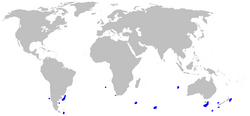Biology:Southern sleeper shark
| Southern sleeper shark | |
|---|---|

| |
| Scientific classification | |
| Domain: | Eukaryota |
| Kingdom: | Animalia |
| Phylum: | Chordata |
| Class: | Chondrichthyes |
| Subclass: | Elasmobranchii |
| Subdivision: | Selachimorpha |
| Order: | Squaliformes |
| Family: | Somniosidae |
| Genus: | Somniosus |
| Species: | S. antarcticus
|
| Binomial name | |
| Somniosus antarcticus Whitley, 1939[2]
| |

| |
| Range (in blue) | |
The southern sleeper shark, or Whitley's sleeper shark (Somniosus antarcticus), is a deepwater benthopelagic sleeper shark of the family Somniosidae found in the southern and subantarctic extremes of the Atlantic, Indian and Pacific Oceans, and some northern reaches of the Antarctic oceans.[1] It has been recorded near the southernmost areas of South America (such as Tierra del Fuego and the Strait of Magellan), near South Africa , southern Australia, Tasmania and New Zealand, as well as more remote locations in the south-central Indian Ocean.
Taxonomy
It was formerly sometimes viewed as conspecific with either the Greenland shark (Somniosus microcephalus), or the Pacific sleeper shark (Somniosus pacificus).[3]
Habitat
A deepwater species, the southern sleeper shark is known to frequent waters around 400m (1312 feet) to as deep as 1100m (3608 feet).[1][4]
Description
The southern sleeper shark’s body length measures up to 4.4 m (14 ft).[4] This species differs from the Greenland shark (S. microcephalus) with the presence of additional rows of teeth in its lower jaw, a shorter interdorsal region, a more posterior first dorsal fin, and fewer precaudal vertebrae. Compared to both the Greenland and the Pacific sleeper shark (S. pacificus), the southern sleeper has lower dorsal fins, which the other two do not.[3]
Diet
The southern sleeper shark feeds primarily on cephalopods, especially squid — including the giant and colossal squids — and numerous fishes. Documented stomach contents of individual sleeper sharks have also, albeit infrequently, contained the remains of marine mammals or seabirds, possibly as a result of scavenging on sunken carcasses or whale falls.[1] Based on its generally sluggish nature and the comparative speed of its prey, it is thought to be an ambush predator.[1] A 3.6 m (12 ft) long female, caught off the coast of Chile , had a whole southern right whale dolphin in its stomach. This dogfish is sometimes taken as accidental bycatch in the orange roughy and Patagonian toothfish fisheries; whether or not this poses a threat to the species is currently unknown.[1]
Conservation status
In June 2018 the New Zealand Department of Conservation classified the southern sleeper shark as "Not Threatened" with the qualifiers "Data Poor" and "Uncertain whether Secure Overseas" under the New Zealand Threat Classification System.[5] The IUCN also does not regard it as threatened, noting a widespread distribution and no indication of a declining population, but believes it is not naturally abundant and that much more data and understanding of its population, interactions and biology is needed.[1]
References
- ↑ 1.0 1.1 1.2 1.3 1.4 1.5 1.6 Finucci, B. (2018). "Somniosus antarcticus". IUCN Red List of Threatened Species 2018: e.T41857A68643703. doi:10.2305/IUCN.UK.2018-2.RLTS.T41857A68643703.en. https://www.iucnredlist.org/species/41857/68643703. Retrieved 16 November 2021.
- ↑ Whitley, Gilbert P. (1939). "Taxonomic Notes on Sharks and Rays". The Australian Zoologist 9 (3): 242. https://biodiversitylibrary.org/page/38926876.
- ↑ 3.0 3.1 Yano, Kazunari; Stevens, John D.; Compagno, Leonard J. V. (2004). "A review of the systematics of the sleeper shark genus Somniosus with redescriptions of Somniosus (Somniosus) antarcticus and Somniosus (Rhinoscymnus) longus (Squaliformes: Somniosidae)". Ichthyological Research 51 (4): 360–73. doi:10.1007/s10228-004-0244-4.
- ↑ 4.0 4.1 Froese, Rainer and Pauly, Daniel, eds. (2012). "Somniosus antarcticus" in FishBase. February 2012 version.
- ↑ Duffy, Clinton A. J.; Francis, Malcolm; Dunn, M. R.; Finucci, Brit; Ford, Richard; Hitchmough, Rod; Rolfe, Jeremy (2018). Conservation status of New Zealand chondrichthyans (chimaeras, sharks and rays), 2016. Wellington, New Zealand: Department of Conservation. pp. 11. ISBN 9781988514628. OCLC 1042901090. https://www.doc.govt.nz/globalassets/documents/science-and-technical/nztcs23entire.pdf.
Wikidata ☰ Q4667506 entry
 |


